|

MAREMMANO ABRUZZESE SHEEPDOG
Author: Gianni Vullo owner of the Loro Del Piana kennel

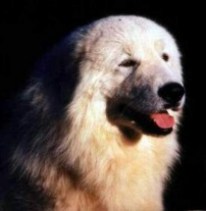 
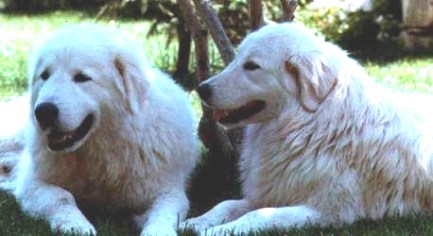

Standard of the Maremmano Abruzzese Sheepdog: click here
THE TRANSHUMANCE IN ITALY.
The economic-social historiography has always only turned its attention on agriculture, as if it was the only form of use of the land, neglecting animal raising activities, at least until this has not interested the economic politics of Italy. In substance, the central position of the sheep breeding in Italian productive life has been ignored. Also there were historical periods when particular environmental conditions blocked every other possibility of use of the land.
"The humble sheep is a perfect user of the whole production of vegetable biomass that would not be economically consumable by other animals bred by man" (Prof. Franco Cazzola). Also, according to K. D. White the sheep "is the most efficient manufacturer of fertilisers that we know" , and the continuous movement of the flocks on the territory assured the distribution of the fertilizer. There is no doubt that the maintenance of sheep on the pastures contributed to the regeneration of the land, as a farmer would not have been able to accomplish.
The transhumance is the way to conduct breeding using alternatively, distant open spaces and characterised by different climactic conditions. It is therefore the diametrically opposite form to the intensive breeding and it is different because of the wandering of the herds so there was no alternation of the same pastures.
Necessity to make a seasonal transhumance springs from the conformation of the place of residence of the shepherd. The sheep-breeders living on the high mountains of the central Appennino, in winter, were forced to leave the native pastures made uninhabitable because of the cold, by the month of October. The destinations have always been the large lowlands of the Tavoliere in Puglia to the south, of the Roman Agro to the west and of the Maremma Tuscan to the north west.
This was in Italy, but all the Mediterranean countries always have been the scenes of transhumances, even though we must say that the maximum importance of the phenomenon has been in Italy and in the Iberian peninsula.
Fernand Braudel was the first to realize the big historical value of the transhumance conducted over millennia in the whole Mediterranean area, spurring the historians to take an interest in this socio-economic culture that involved not only the animals, but also the men.
Italy in the Middle Ages was a big centre of transformation for the wool industry and this involved the diffusion of sheep in every part of the country.
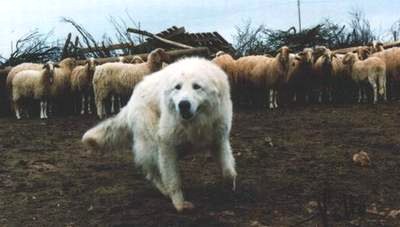
This big movement of sheep was very remarkable up to 1500, that is until the epoch of the wheat conversion and up to and before the importation of Venetian and English wools. The usage of the local product, qualitatively less competitive, lowered drastically and with it also the ovine breeding. This occurred in all the Italian territories.
The sheep that pastured on the Tuscan hills in summer were conducted to the coast of Pisa in winter and to the Maremma, in Grosseto, to be able to survive until the next summer. Therefore in September and May the Maremma district welcomed hundreds of thousands of sheep, arriving there after about ten days walk along the ridges to avoid crossing the water courses.
The Umbrian flocks made transhumance following the trek from the Sibylline Mountains toward the Roman Agro. Some others followed the Flaminia track to reach the Latial Maremma district, others were moved toward the Adriatic coast.
The particular geographic conformation of Italy, as we have seen, has imposed for a long time the transhumance from the high summer pastures of the Appennino to the low countries of the Tavoliere in Puglia, of the Tuscan Maremma and of the Roman Agro districts. All this was because of climatic demands, which make the mountains uninhabitable because of the cover of snow already happening in October. The whole farm was forced to do a trip 300 kilometres long toward the south to find pastures that were not frozen and temperatures that didn't jeopardize the survival of the animals. For a long time, all the flocks that went toward the south or returned home used the roads ploughed by the river of sheep which which consisted of big grassy roads, the so-called tratturi, and used exclusively by the transhumance.
Within the month of April the owner of the flock from the mountains (the locato) had already made the booking of the summer pastures. Almost all the mountainous territory of the Abruzzo was and still is owned by the Communes which once rented it like pastures, assigning a piece of ground according to the number of sheep possessed by the applicants. For a long time this has represented the economic base on which every town administration in that region relied on.
The assignment of the pastures happened by auction with a ceremonious procedure that had a religious meaning. Everything was conducted in the presence of the greatest city authorities, in The House of the Public, with the lighting of candles, from this comes the name of The Auction of the candles.
Immediately after the Fair of Foggia, the first heat of June marked the end of the residence on the Tavoliere, and so the whole farm was put into action to get ready for the walk to the mountains.
The massaro was the first one to start. He was put at the head of the morre. The butteri with the redine were as outriders. The scapoli - after the farm had moved off the enclosures - loaded the nets, the stakes and all the household implements onto the mules.
It was all frantic activity, but well organized during which each had his assignment.
On this occasion nobody was allowed to waste time, and the dogs were watchful of the movements, and spontaneously they prepared for the job of escort of the caravan. Certainly some sheep were detached from the flock, and so there was always some dogs that were particularly skilled in the recovery of these sheep. Some old shepherds of Abruzzo have confirmed to me that in every flock of sheepdogs there was always one dog that was kept for his propensity to reassemble the sheep that had the tendency to disperse. Therefore when we speak about Maremmano-Abruzzese Sheepdogs as guarding dogs we must not think of this definition in an absolute sense, but only as the principal propensity of the breed.
The long procession was always moved in the same order, this was also imposed by the sky: the goats leading, the rams immediately behind, then the sheep di corpo, then the fellate ones, the ciavarre ones and at the end the mules and donkeys. Spontaneously the dogs took their place in the middle of the group and around it.
The "pockmarks" were always the first ones to enter into the village and they accelerated their footsteps in the imminence of the arrival. The entrance was triumphal, also because they had been distant from family affections for eight long months.
The religious rite did its part also in this occasion. The distribution of milk to poor men was a custom of biblical memory and it symbolised that with the sheep the abundance had returned. The whole district assisted in the monta, the milking of the sheep, to fill with milk their cannata that they held in their hands.
In this confusion the dogs were calm and this is exceptional behaviour because they were generally mistrustful toward anything extraneous. The dogs were calm because they understood the climate of a friendly party that the whole district was celebrating.
During the first night after the arrival, the flock remained in the country. The sheep were enclosed inside some small fields and they were entrusted to the exclusive custody of the Maremmano-Abruzzese Sheepdogs. Automatically the dogs had to forget the well-prepared mind that they had shown during the milking of the sheep. They had to again become fierce keepers, suspicious and mistrustful toward whoever had drawn near to the flock.
Consequently, after the long winter loneliness, all the men of the farm were not prepared to spend the night watching the sheep, rather to seek the affections of their wives. Almost all the children of the shepherds were born in the month of March. But the flock was the only capital and the only source of income for the shepherds, therefore the dogs had to show that they were very reliable and trustworthy.
At dawn the following morning the men took back their usual jobs. The milk of the early-morning milking was used for making giuncata that the wife of the locato distributed to relatives and friends.
With the same order kept during the walk along the tratturo, the massaro and the "pockmarks" were started along the road that brought them to the already verdant mountains. In the walk they were followed by the morre and by the dogs; the bachelors remained on the place to load on the mules, the nets, stakes and the last household implements. The job of the "bachelors" demanded great speed because they started last on the path, but they had to come onto the mountain before everybody. In fact they had to prepare the giaccio to welcome the animals on their arrival. The "pockmarks" instead prepared the procojo.
Because of the preparations of the enclosures and of the procojo, because of the evening milking and of the unloading of the equipment it was late at night when they finished. The next day the turns of remnuta started. These turns like the turns of the quindicina were decided by the massaro who communicated them on the occasion of his sudden visits on the mountains. During the whole period of the summer stay on the mountains the massaro worked in the house of the locato, he didn't reside on the farm, but he went up on weekly expeditions. When the massaro was not on the mountains the head "pockmark" replaced him.
Since the first day of permanence on the summer pastures the rams were put to the sheep di corpo for around a month , one morra used 23 or 25 rams (it was superstition, that the number of rams had to be always odd ). In September and October the same thing was done with the fellate.
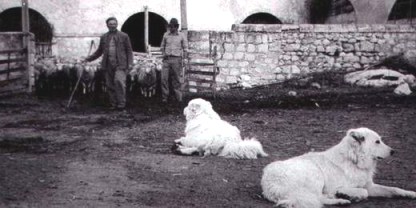
During the residence on the pastures of Abruzzo, the shepherds did the so-called discards to sell in the market for the butchery. In these phases our dog was not immovable. There were dogs that did everything possible to gather rebellious sheep, and dogs that were used only to signal the leaving of some animal. There were dogs that followed the group of sheep brought to market, and there were the dogs which preferred to remain at the farm. A very varied job was the job required of our breed in daily life.
In September the budding of the first poisonous send away shepherds and the cold nights gave the shepherds the signal that the time had arrived to abandon the high pastures to reach the more moderate climate of the Tavoliere.
After the finishing of the turns of the crusta , the mimic ritual of the scasata started. The pockmarks uncovered the procojo to save the wood from the winter rains, the bachelors loaded every utensil on the mules while the pockmarks and the other shepherds went with the morre along the descent toward the village. There they remained one night, as they had done some months before when they returned from the winter pastures. This time however there was not the distribution of milk because the sheep were pregnant therefore dry.
At dawn the next day the caravan began the long trip toward the south that lasted around 15 days. It was interrupted only by uncomfortable standstills. Reaching the Tavoliere, the farm remained there until the Fair of Foggia ended (the end of May).
To understand after all this, the importance of the Maremmano-Abruzzese Sheepdog in the context of this pastoral life we can do no better than listen to what was written by Ettore D'Orazio who lived until 1900.
It is necessary to remember however that D'Orazio calls our breed the "mastiff" . This was what the dog keeper of sheep was called in the pastoral environment. It is different from the molossian dog which was generally dark, with its hair like a cow and called instead "corso" .
In France the matin and in Spain the mastin. These are words that identify the type of dog similar to the Maremmano-Abruzzese Sheepdog (Mastin de Navarra, Mastin de Leon).
This is what Ettore D'Orazio wrote:
"During the night the aspect of the giaccio has the desolation of uninhabited hermitage and the melancholy immobility of the pictures of still-life. Especially in the nights without a moon, a funeral shroud covers the procojo and the mandre, removing every semblance of life (...). But an uncertain whiteness of the sky finally announces the near dawn and the fresh early-morning breeze is spread out like a breath of life on the dormant giaccio (...). Upright in front of the procojo or around the mandra the already awake mastiffs seem like white look-outs listening. It is the time of the early-morning milking (...). Sometimes in the sharp night time darkness a sudden tumult upsets the quiet of the farm and the silence is broken by a big clamour and suddenly the whole forest is filled with howls, of barking and of cackles. It is the bear, the classical beast of the central Appennino which can be met still today in the highest and impervious tops of this region, in Pescasseroli, in Scanno, and in Bisegna. The beast, that is an exemplary survivor of past epochs, advances with sure footsteps between the enclosures of the camp. It withdraws with its powerful fangs a sheep and goes away regardless of the cries of shepherds and of the barks of dogs as a king of the ancient times who takes his tax.
More often it is the wolf, the traditional enemy of the peaceful herd. The wolf approaches the flock cautiously eluding the tired vigilance of the dormant mastiffs. At the first moans of the attacked flock the mastiffs are lifted up and they are launched like arrows toward the place that their smell points out, barking incessantly. It is the special bark that points out the wolf, a dry bark, without standstill, dense and that the herdsmen immediately recognize. The shepherds emerge immediately from the hut, dressed like they were in their pallets. They go in groups, in the direction of the attacked flock brandishing ardent brands, poles and hairpins. Their assignment is only to incite the dogs to the assault by voices and hisses that the pastoral slang prescribes:
- Oussss, tah here here here here here here; - Lee oh! Oussss take, oussss, tah tah tah tah ...
The mastiffs immediately surround the wolf, and they surround with a circle of voracious barking mouths, barking incessantly, furious, incompatible, with an attitude of aggression that is rarely seen except in a fray. In the centre of the circle the wolf snarls, furious for the imminent danger and lost and raging also. It checks the assailants showing its acute teeth continually; then it lifts its tail in action of supreme threat and it turns around itself careful always to avoid the bites of the dangerous aggressors, always scrutinizing a weak point that can offer it a passage. Its eye is tenaciously intent to the neck of the mastiffs that it would bite very gladly if there had not been the wide iron collars with sharp points. And sometimes, made blind from anger it bites the points however hurting seriously its mouth.
But finally the passage opens. It is a young dog which is guilty and still inexperienced and which has been afraid of the threatening aspect of the wolf; or it is an old feeble bitch because the tiredness of barking has made its voice hoarse. The dog demotes for an instant or it approaches the nearest companion to ask for help. An instant is enough and the wolf passes, it moves like lightning and it penetrates into the wood taking with it every memory of its raid. It leaves only some bite given or received and some killed sheep".
------------------------
Gianni Vullo is dog-judge for E.N.C.I. and breeds Maremmano-Abruzzese Sheepdogs from 1988 and his dogs have conquered: 2 Italian championships, 2 International championships, 2 Young Italian championships, 2 Foreign championships, 3 Australian championships, 10 progeny championchips.
Gianni Vullo breeds for the beauty and health of his dogs and he has written a book on this breed that is translated in English also. He is the titular of the LORO DEL PIANA kennel and his puppies have gone to America, Australia, South Africa and Russia.
LORO DEL PIANA kennel (Italy)
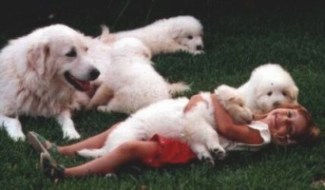 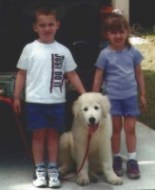

Back

|











